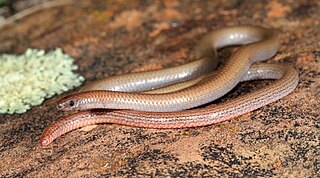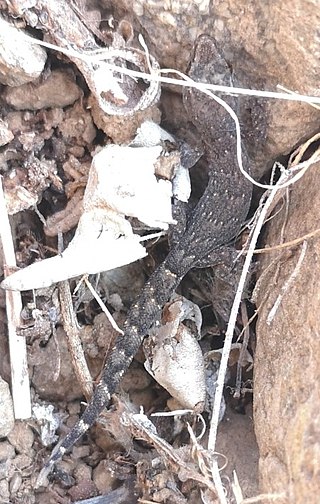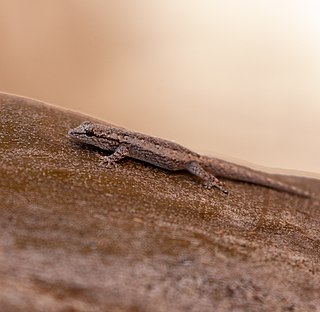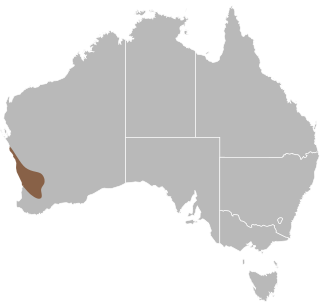Related Research Articles

Pygopodidae, commonly known as legless lizards, snake-lizards, or flap-footed lizards, is a family of squamates with reduced or absent limbs, and are a type of gecko. At least 35 species are placed in two subfamilies and eight genera. They have unusually long, slender bodies, giving them a strong resemblance to snakes. Like snakes and most geckos, they have no eyelids, but unlike snakes, they have external ear holes and flat, unforked tongues. They are native to Australia and New Guinea.

Diplodactylus is a genus of geckos of the family Diplodactylidae from Australia. They are sometimes called stone geckos or fat-tailed geckos. Member species are morphologically similar but genetically distinct.

Aprasia is a genus of lizards in the family Pygopodidae. The genus is endemic to Australia. The species in the genus Aprasia are worm-like, burrowing lizards. At least four of the species are oviparous.
Robert Friedrich Wilhelm Mertens was a German herpetologist. Several taxa of reptiles are named after him. He postulated Mertensian mimicry.

James Ray Dixon was professor emeritus and curator emeritus of amphibians and reptiles at the Texas Cooperative Wildlife Collection at Texas A&M University. He lived in El Campo, Texas, throughout most of his childhood. He published prolifically on the subject of herpetology in his distinguished career, authoring and co-authoring several books, book chapters, and numerous peer reviewed notes and articles, describing two new genera, and many new species, earning him a reputation as one of the most prominent herpetologists of his generation. His main research focus was morphology based systematics of amphibians and reptiles worldwide with emphasis on Texas, US, Mexico, Central America, and South America, although bibliographies, conservation, ecology, life history and zoogeography have all been the subjects of his extensive publications.
Norman Edouard "Kibe" Hartweg was an American herpetologist, Curator of Herpetology for the Museum of Zoology at the University of Michigan, and president of the American Society of Ichthyologists and Herpetologists. He was a specialist in the taxonomy and distribution of turtles, and is honored by having a subspecies of turtle named after him: the western spiny softshell turtle, Apalone spinifera hartwegi. He is also credited with having described several new species, including the Big Bend slider, Trachemys gaigeae, the Oaxacan patchnose snake, Salvadora intermedia, and Dunn's hognose pit viper, Porthidium dunni.
Donald Ward Tinkle was a prominent herpetologist, ecologist, and evolutionary biologist at the University of Michigan until his illness and death at age 49. He is best known for his intensive demographic studies of lizards, which involved full censuses of local populations repeated over several years to obtain life table parameters such as age at maturity, survivorship, and reproductive effort. He was a pioneer in developing life history theory along with key students including Henry Wilbur, Michael Hirshfield, and Arthur Dunham, and he was an important collaborator with Dr. Richard D. Alexander in the application of individual selection theory and sociobiological ideas to varied organisms including humans.

The Flinders Ranges worm-lizard is a species of lizard in the Pygopodidae family endemic to the state of South Australia. The name derives from the Flinders Ranges.

Crenadactylus, the clawless geckos, are named for their distinguishing feature, the absence of terminal claws on the digits. They are the only Australian members of Gekkonidae to lack claws, the endemic genus is also the smallest in size.

The Carphodactylidae, informally known as the southern padless geckos, are a family of geckos, lizards in the infraorder Gekkota. The family consists of 32 described species in 7 genera, all of which are endemic to Australia. They belong to the superfamily Pygopodoidea, an ancient group of east Gondwanan geckos now only found in Australasia. Despite their well-developed limbs, molecular phylogenies have demonstrated that Carphodactylidae is the sister group to Pygopodidae, a highly specialized family of legless lizards.

Delma molleri is a small [the snout-vent length of the largest specimen measured 111 mm (4.4 in)], limbless lizard found in southern South Australia around the Adelaide Hills, and pretty common in Adelaide suburbs. Delma molleri has been recorded from a variety of habitats ranging from grassland to woodland beneath rocks, timber, and rubbish. The species is oviparous.

The Chilean marked gecko is a species of lizard in the family Phyllodactylidae. The species is endemic to Chile, in the Chilean matorral ecoregion. There are three recognized subspecies.

The pink-tailed worm-lizard or granite worm-lizard is a rare legless lizard found in Australia. The animal looks like a combination of small snake and worm. Its total length is up to 14 cm. It has a pink tail and is white underneath. The head and neck are brown, and the rest of the top of the body is pale grey. Scales on the back each have a dark bar, giving the appearance of dots down the back. It is found on two hills near Tarcutta, Bathurst, New South Wales, Bendigo in Victoria, and along the sides of the Molonglo River and Murrumbidgee River and on Mount Taylor in the Australian Capital Territory. The lizards eat invertebrates that live under rocks. They can be found under rocks sized from 0.15 to 0.6 m. Their main diet is ant eggs, particularly from Iridomyrmex species and Rhytidoponera metallica.
Diplodactylus klugei is a species of gecko, a lizard in the family Gekkonidae. The species is endemic to Australia.
Cyrtodactylus klugei is a species of gecko, a lizard in the family Gekkonidae. The species is endemic to Papua New Guinea.

Kluge's dwarf gecko is a species of gecko, a lizard in the family Gekkonidae. The species is native to northeastern Brazil.

Delma grayii, also known commonly as Gray's legless lizard, Gray's scalyfoot, and the side-barred delma, is a species of lizard in the family Pygopodidae. The species is endemic to Australia.

The patternless delma is a species of legless gecko from the Pygopodidae family. This species is commonly found throughout New South Wales, Queensland and southeastern South Australia, mostly inhabiting areas consisting of dry to temperate southern grasslands and grassy woodlands.

The Mallee Worm-lizard , also known as the Pink-nosed Worm-lizard and the Red-tailed Worm-lizard, is a slender pygopid species that is endemic to Australia, with recorded distribution across the four southern mainland states, although, its distribution is restricted in Western Australia and New South Wales.

The Zuytdorp worm-lizard, also known commonly as Smith's legless lizard, is a species of lizard in the family Pygopodidae. The species is endemic to Australia.
References
- 1 2 Beolens, Bo; Watkins, Michael; Grayson, Michael (2011). The Eponym Dictionary of Reptiles. Baltimore: Johns Hopkins University Press. xiii + 296 pp. ISBN 978-1-4214-0135-5. ("Kluge", p. 143).
- ↑ "Faculty History Project, Memoir, Arnold G. Kluge, Regents' Proceedings 341". University of Michigan. Retrieved May 14, 2020.
- ↑ Dixon, James R.; Kluge, Arnold G. (26 March 1964). "A New Gekkonid Lizard Genus from Australia". Copeia. 1964 (1): 174. doi:10.2307/1440848. JSTOR 1440848.
- ↑ Aprasia pseudopulchella at the Reptarium.cz Reptile Database
- ↑ "Aprasia pseudopulchella — Flinders Ranges Worm-lizard". Species Profile and Threats Database . Department of Climate Change, Energy, the Environment and Water, Australian Government. 2023. Archived from the original on 25 August 2023. Retrieved 25 August 2023.